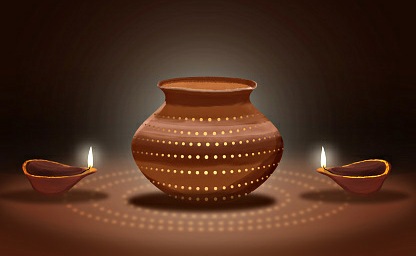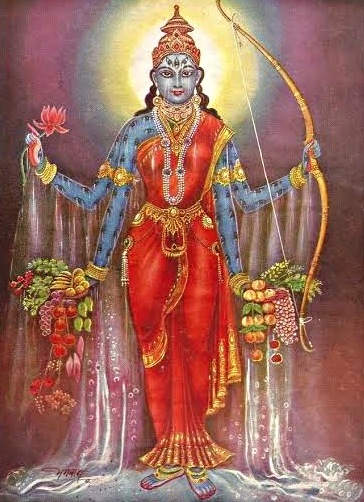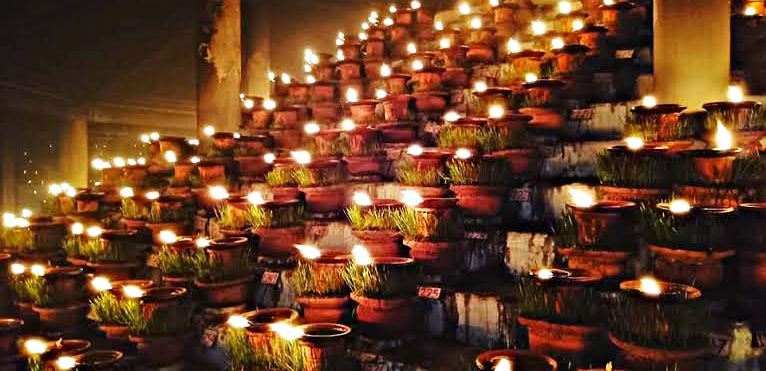Shakambari Navaratri (शाकम्भरी नवरात्री) is one such celebration which is connected to the mother Nature. All the Devi symbolism in Vedic literature ultimately reflects our own power (shakti) (शक्तिः) within. In Hinduism, the Goddess or Feminine form is worshipped in many ways & is given utmost importance. As we have seen that there are different days or months which are connected to worship particular gods/goddesses likewise; Navratri is the festival which is connected for worshipping Goddess only.
According to the Hindu Scriptures, there are total five (05) Navratris viz. Pausha, Magha, Chaitra, Aashadha & Ashwina Navratri. Shakambhari Navratri (शाकम्भरी नवरात्री) occurs in the month of Pausha (पौषः). Shakambhari Navratri (शाकम्भरी नवरात्री) is also known as Paushi Navratri (पौषी नवरात्री). This Navaratri generally occurs after Makara Sankranti (मकरः संक्रमणम्), also sometimes it occurs before Makara Sankranti (मकरः संक्रमणम्) depending upon the transition of the Sun (सूर्यः) & the moon (चन्द्रः) according to the Hindu Panchang (पञ्चाङ्गम्). Shakambhari Navratri (शाकम्भरी नवरात्री) is celebrated from the 8th day of the bright fortnight of the Pausha month (पौषः शुक्लपक्षे अष्टमी) & ends on the full moon day i.e., 15th day of the bright fortnight of the Pausha month (पौषः शुक्लपक्षे पूर्णिमा). According to the Georgian upcoming year, Shakambhari Navratri (शाकम्भरी नवरात्री) will be celebrated on the 10th of January 2022 & Purnima (i.e., last day of Shakambhari Navratri) will be on 17th January 2022.
This day is of great importance in many regions in India. This Navratri is dedicated to the Goddess Shakambhari & this form of Adi Shakti is worshipped during this Navratri. Goddess Shakambhari is an incarnation of Goddess Parvati. She is the Goddess of vegetable, fruits & other vegetations due to which this form of the Goddess is also known as the symbol of greenery. The word Shaaka means vegetables & Ambhari means the one who bears so, the literal meaning of the name Shakambari is, “the bearer of the vegetables” & also “the Goddess of vegetation”.

Significance of Shakambhari Navratri (शाकम्भरी नवरात्री) –
Every Navratri starts from the first day of the bright fortnight (शुक्लपक्षे प्रतिपदा) & ends on the ninth day of the bright fortnight (शुक्लपक्षे नवमी) but, Shakambhari Navratri (शाकम्भरी नवरात्री) is the only Navratri which starts from the eighth (8th) day of the bright fortnight (पौषः शुक्लपक्षे अष्टमी) & ends on the fifteenth (15th) day of the bright fortnight of the Pausha Month (पौषः शुक्लपक्षे पूर्णिमा). As we all know that, Adi Shakti is Mother Nature & she nurtures this whole universe in the same way for the welfare of the people, Adi Shakti took a form of the Goddess Shakambhari on the 8th day of the bright fortnight of the Pausha (पौषः) month & because of this reason this Navratri is celebrated from the 8th day & not from the 1st day of the Pausha month. She took the form of Goddess Shakambhari & nourished all the creatures during the greatest drought. As she took care of every being during the hard times, she is honoured & worshipped every year for 8days. As Adi Shakti transformed in the Goddess Shakambhari on this day, this Navratri is also celebrated as the birthday of Goddess Shakambhari & so, this day is also known as Shakambhari Jayanti.
Shakambhari Navratri holds a great significance in Hinduism as it is connected to the vegetation likewise, the Shakambhari Purnima i.e., the Purnima of the Pausha month has its significant importance too. According to the Scriptures, when people perform a sacred bath on this special day then they attain Liberation as well as they acquire huge merits by donating on the day of Shakambari Purnima. At various places in India, Pausha Purnima (पौषः शुक्लपक्षे पूर्णिमा) is widely celebrated as it is considered as the most important day as per the Hindu calendar. Major Temples dedicated to Goddess Shakambhari are located in Bangalore, Karnataka, Maharashtra, Uttar Pradesh & Rajasthan. In Karnataka, she is known as Goddess Banashankari & Banada Ashtami is a major event during Shakambhari Navratri. Except these states, Hindus of other regions also celebrate this day with great enthusiasm & faith.

Legend of Goddess Shakambhari –
Every festival has its connection to the traditional Indian History, in the same way this Navratri also has its legend connected to this festival. According to the Devi Bhagavata Purana, Once the descendant of Hiranyaksha named Ruru had a son named Durgam. As Durgam was born to the demon clan, he was fearless, evil & terrible demon. He created terror in the three worlds. In an attempt to rule over all the three worlds, he started a penance to please Lord Brahma. He did penance without partaking food or water for over a thousand years. Pleased with his sincerity & devotion, Lord Brahma appeared in front of him & offered a boon of his wish. The demon Durgam demanded that he wants the possession of all the four Vedas along with more valour than the Gods. Lord Brahma granted his wishful boon.
As he took the possession of the Vedas; the sages, brahmins, saints, humans & Gods failed to recall the Vedas due to which Vedic practices like Sandhya Vandana (संध्या-वंदनम्) (daily rites), Nitya Homa (नित्य-होमः) (daily sacrifices), Yagna (यज्ञः) (sacrificial rituals), Shraddha (श्राद्धम्) (a ceremony performed to honour the ancestors) & Japa (जपः:) (muttering of prayers) were destroyed. Since Yagnas (यज्ञः) (sacrificial rituals) were not performed, the offerings could not reach the Gods in the heavens & therefore they started losing their power & effulgence. Since there were no Yajnas, there were no rains & the three worlds suffered a severe drought. There was no fire to burn dead bodies & no water to grow crops.
Shrimad Bhagavad Gita explains the importance of Vedic Sacrificial rituals in the 14th shloka of the 3rd chapter that;
अन्नाद् भवन्ति भूतानि पर्जन्यादन्नसम्भवः।
यज्ञाद्भवति पर्जन्यो यज्ञः कर्मसमुद्भवः।।
Meaning – From food creatures are born, food is produced by rain. Rain is produced by sacrifice, & sacrifice originates from the action.
Due to lack of rain, it was not possible to grow vegetation due to which humans & animals were dying. Due to this there occurred dreadful drought in the whole world. Gods were losing their power so in self-protection from demon Durgam they hid themselves in the mountain caves. Witnessing all these, the brahmins & sages started pleasing Adi Shakti to protect humans from this dreadful period. For a prolonged days they were pleasing Goddess through shlokas & accepting their prayers mother Goddess appeared in front of them in the form of Goddess Shakambhari. The form of Goddess Shakambhari is full of thousands of eyes & she was of exquisite beauty & compassion. Her complexion is like blue lotus; she has four hands, in one hand she is holding pink lotus, another hand she has bow as a weapon, in third & fourth hand she is holding fruits & vegetables. While witnessing the sufferings of the worlds, she started shedding abundant tears out of her thousands of eyes for nine nights & those tears took a form of water & started flowing on the earth as rains & rivers. The world flourished once again & the beings started thriving with nourishment. She also offered fruits & vegetables to the world & filled the huger of all the creatures.
Later, she took a furious form which is known as Shatakshi Devi & destroyed the demon Durgam rescued the Vedas from him & handed back to Lord Brahma & again everything got proceeded in the same normal way.

Ritual ceremony of Shakambhari Navratri (शाकम्भरी नवरात्री) –
Devotees wake up early & perform a holy bath & then offer homage to the idol of Goddess Shakambhari. Many devotees chant the Banashankari Pratah Smaran Mantra on this Navratri. The idol of Goddess Shakambhari is adorned with fruits & seasonal vegetables during this whole Navratri, especially on the Purnima at the home as well as in the temples. Devotees visit the temple of Goddess Shakambhari or any other Goddess’s temple. Fruits & food made out of seasonal fresh vegetables are offered to the Goddess during this Navratri. Devotees observe fast during these days by partaking only fruits or only vegetables. The one who observes the fast read the Shakambhari Katha- a story of the incarnation of Goddess Shakambhari. Devotees also offer donations during this Navratri & donating on the Purnima has a great significance.
Just like other Navratris, devotees also install the clay pot which is the symbolic of Goddess & worship it every day with five worshipping practices (पञ्चः उपचारः). Also, few grains sow in the soil before few days in a small area which is worshipped during Navratri which is known as “Jawara”. This Jawara is offered water daily & taken care of. After few days crop grow big which is immersed in a river or pond after Navratri with rituals & great respect. Many devotees also light a lamp (दीपम्) which stays on day & night for 8 days & 8 nights during Shakambhari Navratri (शाकम्भरी नवरात्री). This lamp (दीपम्) is also worshipped & is taken care of.
Thus, Goddess is the most vital part of Sanatana Dharma & is worshipped with great respect as she is the Life-giver & nourisher of this universe. Hindus not only worship Goddesses but we also worship & respect every female as we consider her as a part of Adi Shakti. Though this Navratri is only celebrated for 8 days, it holds the same vital part in Hinduism & is celebrated with great enthusiasm & faith. Just as the vegetation is important to nourish our body, in the same way Shakambhari Navratri (शाकम्भरी नवरात्री) is important for spiritual as well as material life. Again, a festival which is connected to the mother Nature & such festivals give the moral of protecting, saving & conserving the nature. May all the Hindus, especially Hindu young generation understand the essence of our culture, our connection to mother Nature & preserve this treasure of Hinduism & pass it on to the next generation.
अश्विनः शुक्लपक्षे ०६, २०७७
